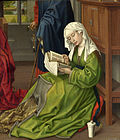Rogier van der Weyden

Rogier van der Weyden or Roger de la Pasture (1399 or 1400 – 18 June 1464) was an early Flemish painter. His surviving works are mainly religious triptychs, altarpieces and commissioned single and diptych portraits. He was very successful and internationally famous in his lifetime. His paintings went to Italy and Spain.[1] By the end of the 15th century, he had become more popular than Jan van Eyck. His fame lasted only until the 17th century.
Due to the loss of archives in 1695 and again in 1940, there are few certain facts of van der Weyden's life.[2] Rogelet de le Pasture (Roger of the Pasture) was born in Tournai in 1399 or 1400. His parents were Henri de le Pasture and Agnes de Watrélos. He married around 1426, to Elisabeth Goffaert. He was made town painter of Brussels in 1436. He changed his name from the French to the Dutch format, becoming 'van der Weyden'.
Gallery[change | change source]
-
Portrait of a Young Woman, c. 1435
-
Saint Luke Drawing the Virgin, c. 1435–40. The setting is derived from the Madonna of Chancellor Rolin by Jan van Eyck
-
The Magdalen Reading, one of three surviving fragments from a lost altarpiece, c. 1435-38
-
Chroniques de Hainault miniature, 1447
-
Polyptych with the Nativity, Workshop of Rogier van der Weyden, Metropolitan Museum of Art
-
Portrait of Isabella of Portugal, c. 1445–50
-
Tryptich of the Braque family (closed) c 1450, Louvre
-
Portrait of Charles the Bold, 1460
-
Portrait of Antoine, bastard of Burgundy, c 1460
-
Portrait of Francesco d'Este, c 1460
-
Portrait of Philip de Croÿ, c 1460
References[change | change source]
- ↑ Deposition was taken by Philip II of Spain
- ↑ Campbell (1998), 392
Other websites[change | change source]
![]() Media related to Rogier van der Weyden at Wikimedia Commons
Media related to Rogier van der Weyden at Wikimedia Commons











